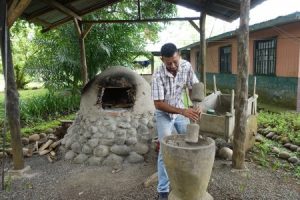
While visiting Sarapiqui, Costa Rica, I had the pleasure of meeting Johnny. He is is trying to rescue his native culture by creating handmade Chorotega pottery. His designs are influenced by Aztec and Mayan culture. At the age of nine, his grandmother started teaching him the basic skills.
His pottery is unique in many ways. He travels to a Guanacaste mine to gather a traditional mixture of clay. The clay has two parts soil to one part of sand. It takes over a week to gather materials and then bringing them back to his Sarapiqui home.
His two kids stomp on filled bags to mix together the traditional ingredients. Johnny is trying to pass down his heritage to his son and daughter. Through an interpreter, he candidly expresses his frustrations. “Technology is taking my heritage away. My son would rather talk on a phone or use the Internet than do clay.”

Johnny uses his brawn to pulverize the dirt and sand mixture.

Over time, he is able to produce an extremely fine compound.
His pottery wheel is primitive. It is not powered by electricity or by foot power. Instead, he methodically moves the wheel by hand. The end result are pieces that are slightly asymmetrical.

Johnny uses a variety of modern and traditional materials to smooth out the clay. Next, he adds on the native as well as modern designs. He uses red, orange, black, and cream colored pigments to decorate his pieces. Each step is a labor of love.
The images have traditional significance. Here are a few examples:
- Spiral= long life
- Triangle= top part of the world
- Geckos and monkey= good luck
- Flowers, hummingbirds & butterflies= beauty
- Macaw= union and fidelity
- Crocodile= power
- Turtle= fertility

After the clay pieces are completed, the pottery need to dry 3-4 days in the shade. He carefully uses a sharp instrument to carve around his painted designs.
A wood-burning kiln fires the clay. The wood is placed in a crisscross format and is allowed to burn for at least 1+ hour. The kiln is approximately 1500 degrees Celsius. Fifteen to twenty pieces can be placed inside his extremely hot kiln.

During his demonstration, he proudly displayed a variety of pieces. Modern cups have handles while traditional ones don’t. Groups of people usually share a cup without handles.
Water is filtered through a cone shaped piece of pottery. A pedestaled container is designed for cacao, a traditional gift from the gods.
Like indigenous people in other countries, Johnny has faced many challenges. He struggles to make a livelihood. He will soon be relocating to Guanacaste for better opportunities. He has been advocating for the local public schools to educate children about their native cultures. To date, the government has chosen not to support his efforts.
Surprisingly, very few people in the audience were willing to support Johnny’s admirable efforts to preserve his culture by selling Chorotega pottery. Without backing from others, his craft has no chance to survive.
RELATED BLOGS
Zip-lining in Costa Rica—Exhilarating
Five of My Favorite Outdoor Adventures in Costa Rica
Hidden Gems: Discovering the National Theatre of Costa Rica
BIO
Sandra Bornstein is the author of MAY THIS BE THE BEST YEAR OF YOUR LIFE It is available on Amazon.
Sandra’s memoir highlights her living and teaching adventure in Bangalore, India. She is a licensed Colorado teacher who has taught K-12 students in the United States and abroad as well as college level courses. Sandra is married and has four adult sons.
The memoir was a finalist in the Travel category for the 2013 Next Generation Indie Book Awards, the 2013 International Book Awards, the 2013 National Indie Book Excellence Awards, 2013 USA Best Book Awards, and a Honorable Mention award in the Multicultural Non-Fiction category for the 2013 Global ebook Awards.
Really interesting. He seems to really know what he’s doing and that makes for beautiful art.